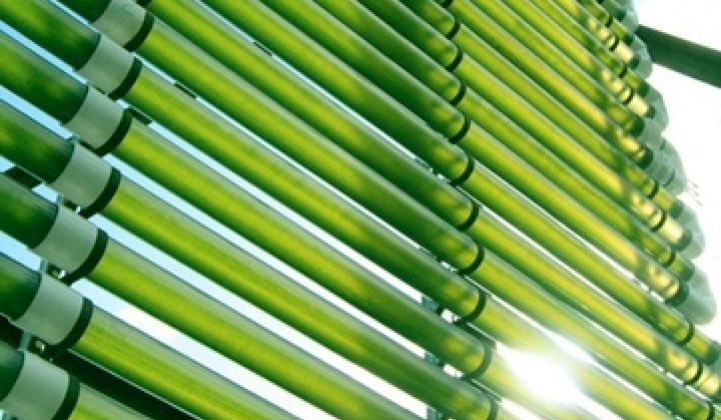It's a farm, and it looks suspiciously like a blade server.
San Jose, Calif.-based Ternion Bio Industries is developing bioreactors – clear tubes for growing algae – that deliberately take their design concepts from blade servers, those thin racks of servers that began to pop up in data centers in the early part of the decade that were based upon racking concepts copied from the telecommunications Industry.
Blade servers became attractive because they cut down on real estate and cables for interconnecting servers, and the same principles are afoot at Ternion. The company wants to build very tall – approximately 32 foot high – racks filled with bioreactors so that a maximum amount of algae can be grown on an acre.
A single acre of its bioreactors can produce as much as 296 acres of "racetrack" algae ponds, according to J. Kyle McCue, Ternion's CEO. The company has erected a prototype at McClelland Air Force Base in Sacramento. McCue, though, quickly added that Ternion does not claim it can get millions or hundreds of thousands of gallons of oil a year from an acre, estimates from some other companies that have been criticized. Still the number seems to be on the high side of output per acre. Ternion is now the 60th company we've looked at with significant plans in algae. Some will make it, but most won't.
Ternion's reactor also cuts down on interconnections between modules in a rack, according to McCue. But instead of wires that carry electrons, the interconnections are tubes for carrying water. Three 32-foot racks are linked by hoses that allow water to circulate through all three racks. McCue, one of the founders, started his career in the IT world and admits that the design of the bioreactors comes from data center design principles.
Bioreactor design remains one of the principal areas of research for companies hoping to grow algae in large quantities. It sounds simple – hang up a plastic bag in the sun and let nature take its course – but the design ultimately impacts the economic viability of an algae venture. Algae in bioreactors feed on carbon dioxide. Circulating carbon dioxide, however, can consume large amounts of energy. Colorado-based Solix says it can cut 90 percent of the cost and energy associated with algae growth with a passive circulation technique.
Separating the water from algae – perhaps the biggest technological hurdle today – can also be impacted by the bioreactor design. (The Palo Alto Research Center has come up with a way to use a vortex to separate algae.)
Ternion's main selling point is that it can produce large quantities of algae consistently and it can work with natural or genetically modified strains.
"I can confidently say that batch after batch will be the same," he said.
To ensure that light is distributed evenly, it also includes arrays of light emitting diodes to illuminate reactors toward the bottom of a rack. (Uneven distribution of light was one of the principal problems that plagued GreenFuel Technologies. It subsequently went under.) Other companies such as Bionavitas, though, have been working on similar tubular bioreactorsand vertical racks. It remains to be seen if any of these ideas will work in large-volume production.
Like OriginOil and some other companies, Ternion ultimately wants to sell equipment and/or algae feedstock rather than fuel.
"I am a farmer," McCue said.
Fuel won't be a target market at first. Instead, it will try to provide algae to the nutraceutical industry like Solazyme, where algae can fetch $10,000 to $16,000 a ton. Some deals are already in the works, he said.
Photo via Ternion Bio Industries.



